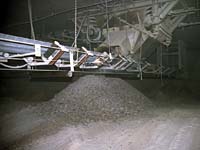

Growing plants have three major nutrient requirements - nitrogen, phosphorus and potassium. Where agricultural soil has been depleted by successive plantings, or where it is naturally deficient, it must be replenished by adding these and other elements through fertilization.
The third nutrient, potassium, is a common element in the earth's crust.
Potassium is usually found in the ground in the form of potassium chloride;
the commercial product is commonly known as potash. Potassium can be removed from the ground only as potash because the element is never found in nature alone. Potassium promotes root growth in plants and assists the absorption of minerals and other important elements.
|

Potash is processed from potassium-bearing ores such as sylvanite, a mixture of sylvite (potash) and common salt. Potassium chloride is the type of potash mined in Saskatchewan, in fact, Saskatchewan's provincial mineral emblem is that of sylvite. As an ore in the ground, potash is usually a mixture of red and white crystals with traces of clay and other impurities. Once processed, it is white in its pure form, but slight impurities usually give it a pink color. Product grade differ in purity and particle size, ranging from a fine powder to a granule half the size of a pea. The finer grades are sold to chemical and manufacturing industries, while the coarser grades are sold as fertilizer. Potash reacts to moisture much as does table salt, so it must be kept dry.
|